Understanding the impact of hotel digital concierges on customer satisfaction
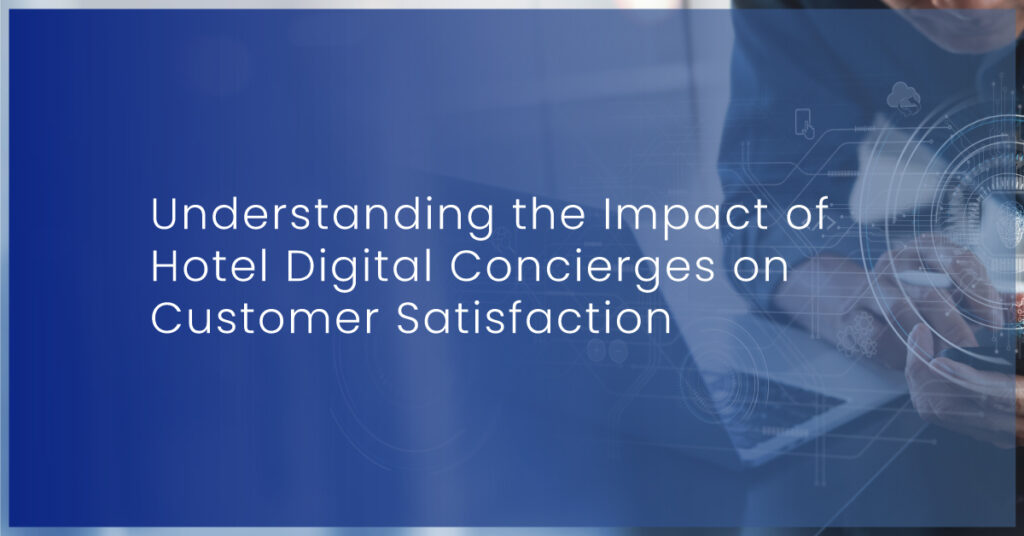
Hotel digital concierges are becoming increasingly popular for hotels to provide personalized service to their guests. To put it simply, a digital concierge is a computer program or app that helps guests navigate their stay at a hotel by providing information about the hotel’s amenities, local attractions, and other services. These digital concierges can be accessed through a hotel’s website or app and often offer an AI-based conversational chat that allows guests to ask questions and receive immediate answers. One of the key benefits of using digital hotel concierges is that they are available 24/7, allowing guests to get the information they need at any time of day. The digital concierges are also a great value addition for guests in a new city looking for recommendations on where to eat or what to do or getting answers to how they can utilize the property’s amenities. What are the prerequisites for using hotel digital concierges? While digital hotel concierges can undoubtedly be helpful for guests, hotels must ensure that they are implemented and used effectively. A poorly designed or difficult-to-use digital concierge can frustrate guests and negatively impact their in-hotel experience. Therefore, hotels need to conduct user testing and gather feedback on their digital concierge to ensure that it meets the guests’ needs. The exercise is critical because if your digitalization efforts are ineffective, it can be frustrating for guests and may lead to counterproductive business outcomes. So, once you have sufficient data that justifies that your digital concierges can provide quick and accurate responses to guests’ questions and needs, you can go full throttle. Some of the initial benefits of introducing digital concierges include: Reduced workload on front desk staff: By using a digital concierge, you can allow your front desk staff to focus on other tasks that require human touch like upselling. Data collection: Digital concierges also help you gather strategically important data on your guests, which can be used to improve the guest experience and increase satisfaction. Eventually, when your digital concierges hit the ground running, you will also witness your operations picking up pace. Speed is the currency for hospitality businesses. As Eric Pearson of International Hotel Group (IHG) says, “It’s no longer the big beating the small, but the fast beating the slow” The Impact of Hotel Digital Concierges on Customer Satisfaction According to a study conducted by Oracle Hospitality, hotels that implemented a digital concierge saw an average increase of 8% in guest satisfaction. Additionally, guests who used the digital concierge had a 10% higher rate of return and a 15% higher rate of recommendation to friends and family than those who did not use the digital concierge. So, it’s statistically proven that digital concierges make business sense. Therefore, it’s important to study the touch points where the concierges directly influence customer satisfaction. Here we analyze five major impact areas where digital hotel concierge better customer experience. Prompt Assistance With a digital hotel concierge, such as branded app installed on in-room iPad, guests can access immediate assistance at any time of day or night. Whether they have a question about their hotel stay or are looking for recommendations on things to do or see in the local area, they can receive a response promptly. It can significantly enhance a guest experience, allowing them to get the information they need without waiting for a response from hotel staff or trying to find it on their own. Personalized Recommendations One of the key advantages of digital hotel concierges is that they can provide personalized recommendations based on a guest’s preferences and past behaviors. For example, the same in-room iPad used for guest support can suggest nearby restaurants that serve the type of cuisine the guest prefers or recommend activities based on the guest’s interests. This level of personalization can make the guest feel valued and appreciated, leading to a more enjoyable and satisfying stay. Convenient Reservations for nearby attractions and events With a digital concierge-like WhatsApp automation, hotels can provide guests links to book tickets for nearby attractions, which also opens a revenue opportunity for hotels. It allows guests to easily make reservations or purchase tickets for events or attractions from their own devices. It saves them time and effort, as they don’t have to call or visit the hotel front desk to do so. Timesaving Hotel digital concierges like real-time brochures help guests save time by providing all the information they need in one place. Rather than searching for information about the hotel’s amenities or local attractions on multiple websites or asking hotel staff for assistance, guests can access the digital concierge for all the information they need. Custom Itineraries Some hotel apps offer the in-app ability to create customized itineraries for guests, allowing them to efficiently plan their stay and make the most of their time in the local area. It can be beneficial for guests who are visiting a new city and want to ensure they take advantage of all must-see sights or activities. Conclusion! Hotel digital concierges are a valuable addition to the modern travel experience. Not only do they provide guests with convenient access to information and assistance, but they also offer the potential for increased satisfaction and loyalty. From personalized recommendations and time-saving convenience to the ability to make reservations and purchase tickets, these digital tools have the power to enhance the guest experience greatly. While hotels must ensure that their digital concierge is user-friendly and provides accurate information, the benefits of implementing these tools far outweigh any potential challenges.
Different terminologies for hotel wholesalers in the travel industry
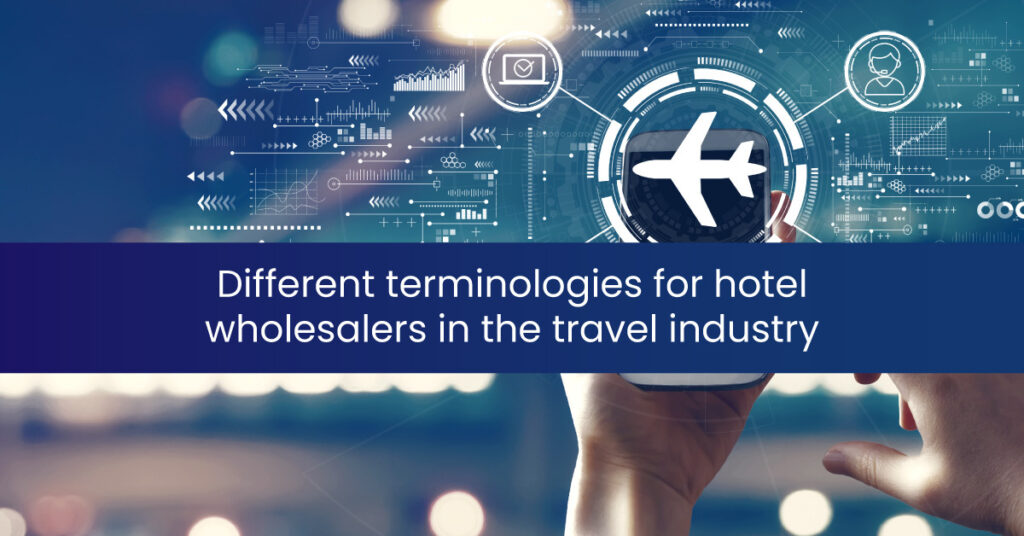
A wholesaler is a third-party marketplace that sources hotel inventory (room nights, rates, hotel amenities, packages) in bulk from hoteliers, and accommodation providers and then sells them to travel sellers such as OTAs, travel agents, DMCs, and tour operators. Travel suppliers offer hotel rooms and hotel content (hotel address, room images, amenities), which is then shared with the travel sellers. From a B2B perspective, wholesalers play a prominent role in connecting travel suppliers (hoteliers) and travel sellers (OTAs, DMCs). Some wholesalers focus on working in niche markets or specific hotel types, while others buy all types of hotels and distribute them globally. Through wholesalers, hotels generate more sales and OTAs get hotel products in bulk at a cost-effective price. Interestingly, wholesalers do not sell or distribute hotel inventory directly to travelers. But, any novice in the hotel and accommodation sector can easily get confused by the complex distribution channel. Along with that, wholesalers are coined with various names that can confuse more about the already complicated hotel distribution system. Here we are to help you know the different names of wholesalers. 11 different names of wholesalers Hotel suppliers Hotel merchants Bed banks Consolidators Hotel brokers Hotel aggregators Hotel vendors Demand partners Hotel providers Hotel banks Hotel distributors Hotel suppliers Wholesalers are also called as hotel suppliers in North Americas. Hotel suppliers play a prominent role in sourcing and acquiring hotel products in bulk and selling them to hotel buyers such as OTAs, tour operators, DMCs, etc. Hotel merchants Long before the evolution of the internet, wholesalers were named hotel merchants. Hotel merchants would sell hotel inventory offline to their networks, which was considered a reliable selling platform for accommodation providers. Bed banks Bed banks are online version of traditional wholesalers and been a part of the hotel distribution for last 20 years. They are B2B platforms that contract supply directly from hotels and accommodation providers in bulk. Wholesalers are named bed banks mostly in European and UK market. Consolidators Hotel consolidators are businesses that buy hotel rooms or accommodations in bulk and resell them at discounted rates to their customers. They don’t have direct contracts as bed banks but function in a similar fashion. Hotel brokers Wholesalers are popularly known as hotel brokers in USA and Mexico. The business operations of hotel brokers are the same as consolidators and thus, sometimes hotel brokers are also called consolidators. Hotel aggregators In the APAC region, wholesalers are commonly named hotel aggregators who became popular in the mid-2000s. Their business model is slightly different from wholesalers; however, they are middlemen in the hospitality industry that rents hotel rooms on lease and takes care of the marketing and operational functions of the hotel. Hotel vendors Wholesalers are also universally known as hotel vendors, selling hotel products to travel buyers such as OTAs, DMCs, TMCs. It’s worth mentioning that hotel vendors are often confused with hotel amenities vendors; however, both vendors are highly different in their business. Demand partners Wholesalers in the travel industry are also popularly called demand partners in the USA. They work with accommodation providers and operate similarly to the traditional wholesalers of the hospitality industry. Hotel providers Hotel providers is another popular name of wholesalers in the B2B marketplace of the USA. They deal with hotel products such as hotel rooms, availability, room rates, amenities and have direct contracts with the hotels. Hotel banks Wholesalers are also commonly known as hotel banks in different regions of the USA. They work like bed banks, buying hotel rooms in bulk and selling to OTAs, tour operators, etc., in bulk at a reduced price. Hotel distributors In some regions of the USA, and Europe, wholesalers are also known as hotel distributors. These intermediaries operate as wholesalers negotiating special discounted rates with accommodation providers and selling it to OTAs, DMCs, tour operators, etc. Wholesalers are considered essential to the travel industry because they are the link between hoteliers and OTAs, metasearch engines, tour operators, DMCs, etc. Wholesalers provide the products and services that travel sellers use to run their businesses, including room nights, rates, hotel amenities, packages and much more. In every region across the globe, the wholesalers are named differently, but their business model is like the traditional distribution. We hope the different names of wholesalers help you understand the competitive hotel distribution landscape better.
How does a conversational AI Chatbot work? Use cases in Travel
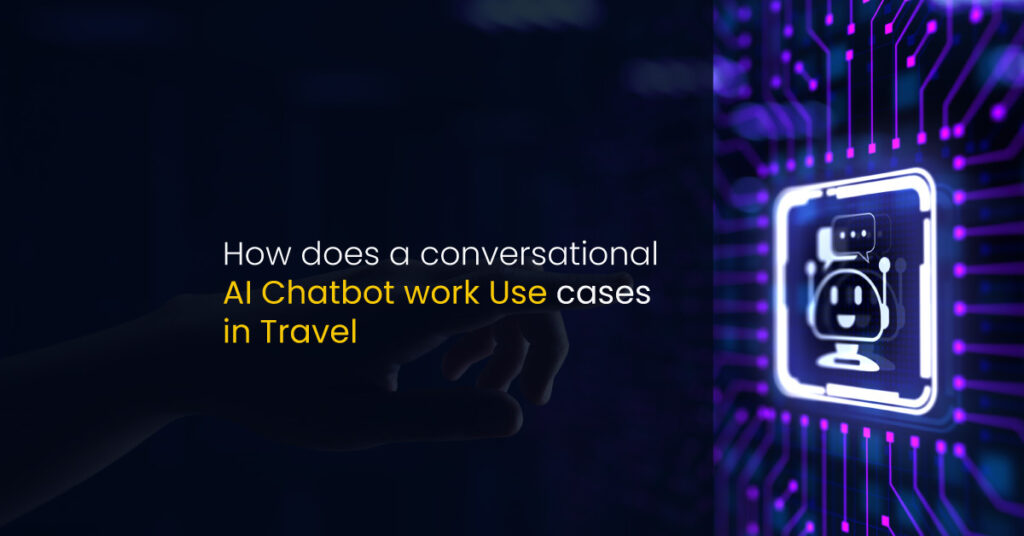
Travel & accommodation is a highly customer-facing industry. At the same time, the volume of travelers is big and traveler expectations are bigger. As many as 100,000 flights take off every day, carrying about 6 million passengers. In short, it’s not a mean task to serve a satisfactory customer experience in an industry as dynamic as travel. Therefore, in the travel industry, there was always a pressing need for automation in customer service. Conversational AI chatbots are greatly serving the travel industry in automating customer service functions. Here, in this article, we will discuss how the whole technology of conversational AI and the bots running on it work. Also, explore emerging and popular use cases of technology in the travel industry for chatbots. How does a conversational AI chatbot work? Think of a conversational AI chatbot as a computer program that can have conversations with human beings. It is usually programmed to answer questions, but it can also be programmed to carry out tasks. The purpose of a conversational AI chatbot is to simulate human-to-human interaction as closely as possible in order to provide the most efficient and effective customer service. It reduces the burden on human customer support executives, they can direct their energies to questions that are more critical and necessarily require human intervention. The travel businesses are now increasingly employing conversational AI chatbots and voice bots to address customers’ queries. Many are calling them “Robo Travel Advisors.” They are helping customers through their journey and becoming end-to-end assistants. Top benefits of using AI travel chatbots Like other travel businesses, conversational AI chatbots can also provide impetus to your customer service efforts. Still, have doubts? Let us declutter them by exploring the top benefits of implementing AI chatbots in travel. Reservation Assistance When customers initiate a booking and shop around options, they tend to develop doubts in their minds. So, the whole journey from interest to finally making a booking decision at many junctures mandates them to interact with either a customer support executive or write to your travel portal. That’s when the function of AI chatbots comes, you know your offerings, and you know the possible apprehensions of travelers. You can train your chatbot with the required information and have your AI chatbot work as an efficient reservation assistant. Booking Manager The conversational AI chatbots today can communicate and respond to travelers with all the necessary information in a similar tone using natural language processing. Moreover, chatbots can make real-time booking modifications, like rescheduling, canceling, or processing refund requests. Also, keep customers updated in scenarios like flight delays due to sudden weather changes, last-minute booking modification requests, and all other dynamic travel requests. So, your AI chatbot can work as a booking manager and deliver quality customer experience across customer touchpoints. Round-the-clock engagement and personalization Travel is a dynamic industry. Customers often need instant help, even if they are in different time zones. AI chatbots can be available 24*7 *365 days a year. Constant availability of customer support enhances the customer experience. As per a Deloitte survey, 92% of the brands see customer experience as a differentiator. Also, the conversation AI chatbot can offer personalized recommendations while helping the customers, creating additional revenue opportunities for your travel business. Data and feedback mechanism AI chatbots also offer a great degree of convenience to customers; they can easily track the communication and access the data they have shared in the chat, especially in cases that require continuous follow-ups. Also, this data is nothing less than a treasure if you look at it in a business sense. You can use the data to create a concrete feedback mechanism. And conduct market research on how your products and services are performing largely. Also, based on conversations, you can offer personalized offerings to your customers. Resolving vague questions Customers do not always ask straight, corrigible questions. With the help of NLP (natural language processing), AI chatbots can make sense of vague queries like “beach la party” or “music live hotel.” The bot identifies the triggered words and searches for the customer’s query to display the best answer. Recommended: Five Ways To Measure The Effectiveness Of Hotel Chatbot Conclusion! The conversational AI chatbots enhance the overall customer experience. And in an industry like travel, the volume of routine queries is larger than unique ones. At times travelers just want to know luggage requirements or room policies. Therefore, AI Chatbots can be a sustainable, affordable ally to your customer service efforts. You can have a leaner customer service staff that caters to queries requiring human involvement.
Calculating a property’s performance: RevPAR, ADR, Occupancy Rate – Learn these hotel metrics and formulae
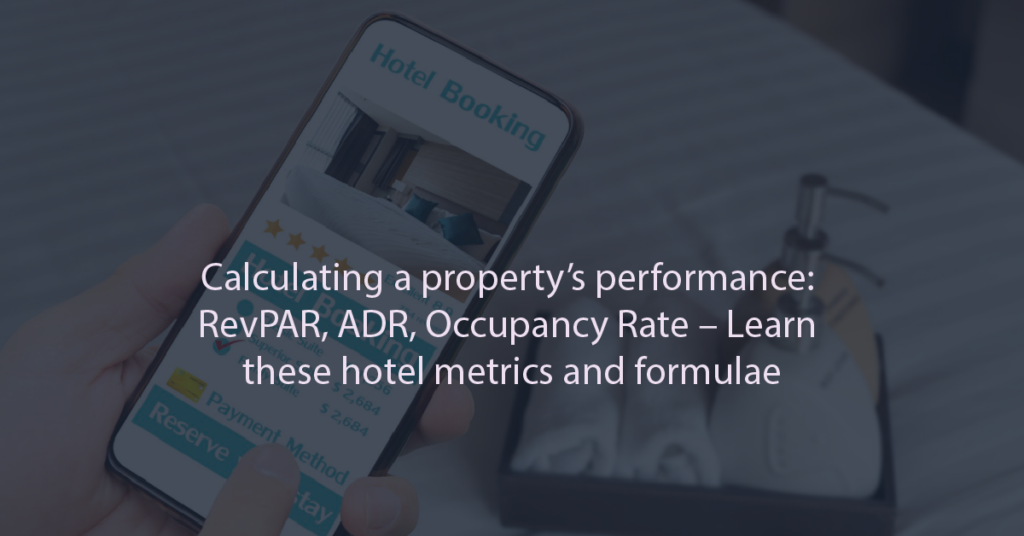
Running a successful hotel business is more than just providing a comfortable bedroom and great customer service. To have a detailed understanding of how your accommodation business is faring now, what you can expect in the future, and what are areas of improvement. You need to be on top of critical hotel metrics. These metrics help you make informed business decisions and most importantly benchmark against competitors. In this article, we will explore these key hotel metrics in detail, explain how to calculate them, and offer some suggestions on how to improve them for the benefit of your hotel business. Now that we understand the importance and benefits of tracking hotel metrics, let’s take a closer look at the three key metrics – Revenue Per Available Room (RevPAR), Average Daily Rate (ADR), and Occupancy Rate. Revenue Per Available Room (RevPAR) RevPAR is the most widely used hotel metric in the industry. It measures the total revenue generated by a hotel per available room. To calculate RevPAR, take the total revenue generated by the hotel and divide it by the total number of available rooms. The result is the average revenue per available room. This metric helps you understand how much revenue is generated on a daily basis. RevPAR is an important metric because it takes into account both the occupancy rate and the average daily rate. A hotel can have a high occupancy rate but a low average daily rate, which would result in a lower RevPAR. On the other hand, a hotel can have a low occupancy rate but a high average daily rate, which would result in a higher RevPAR. By tracking RevPAR, you can determine whether they need to adjust their pricing strategy or marketing efforts to increase revenue. Average Daily Rate (ADR) ADR is the average rate paid for each room sold in a hotel. To calculate ADR, divide the total room revenue by the number of rooms sold. This metric is used to track a hotel’s pricing strategy and can help identify changes that need to be made. ADR is a key metric because it helps you understand how much guests are willing to pay for a room. By tracking ADR, you can adjust their pricing strategy to increase revenue without sacrificing occupancy. A hotel with a high ADR can generate more revenue with fewer rooms sold than a hotel with a low ADR. Occupancy Rate Occupancy Rate is the percentage of available rooms that are occupied. To calculate, divide the number of occupied rooms by the total number of available rooms. This metric helps you understand how well the hotel is attracting customers and filling available rooms. Occupancy Rate is an important metric because it directly impacts a hotel’s revenue. A hotel with a high occupancy rate can generate more revenue than a hotel with a low occupancy rate, even if they have the same ADR. By tracking occupancy rate, you can adjust their marketing efforts to attract more guests and increase revenue. However, it’s important to note that a high occupancy rate doesn’t always mean a hotel is performing well. If a hotel is consistently selling out of rooms, they may need to increase their rates to maximize revenue. On the other hand, if a hotel has a low occupancy rate, they may need to adjust their marketing efforts or pricing strategy to attract more guests. Now, let’s move on to the calculation part, RevPAR and ADR require additional explanation, let’s look at them one by one. Stick around! Calculating Revenue Per Available Room (RevPAR) Calculating RevPAR is a simple process that starts with determining the hotel’s total revenue for a given period, including revenue from rooms, food and beverage, and other sources. Next, you will need to determine the number of available rooms during the same period. Once you have both numbers, divide the total revenue by the number of available rooms. The result is the RevPAR for the given period. The RevPAR Formula First, calculate the total revenue generated by the hotel for a given period. Next, determine the total number of available rooms for the same period. Divide the total revenue by the total number of available rooms. Analyzing RevPAR Results Once you have calculated your RevPAR, it’s important to analyze the results. If your hotel’s RevPAR is low, it may indicate that your pricing or marketing strategy needs to change. For example, you may need to lower room rates or increase marketing efforts to attract more customers. By analyzing RevPAR, you can identify areas for improvement and make changes to improve your hotel’s performance. Calculating Average Daily Rate (ADR) Calculating ADR is also a simple process that starts with determining the hotel’s total revenue for rooms for a given period. Next, determine the number of rooms sold during the same period. Once you have both numbers, divide the total revenue by the number of rooms sold. The result is the ADR for the given period. The ADR Formula First, calculate the total revenue generated by the hotel from room sales for a given period. Next, determine the total number of rooms sold for the same period. Divide the total revenue by the total number of rooms sold. Analyzing ADR results Keep in mind that several factors can affect a hotel’s ADR, including market demand, competition, seasonality, and amenities. By understanding these factors, you can make informed decisions about pricing and marketing strategies that can improve your hotel’s net ADR. Metrics such Revenue Per Available Room (RevPAR), Average Daily Rate (ADR), and Occupancy Rate are used to track a variety of performance indicators. We will discuss them in detail later in this post. But before we move to those explanations, let’s first get clarity on why these metrics are important in a larger scheme of things. Facilitating Decision Making One of the most important benefits of using hotel metrics effectively is to support decision making with data. For example, if a hotel’s occupancy rate is low, it may indicate that the hotel needs to lower its prices or improve its marketing efforts.
Why hotel rate shopping software is pivotal to strategize pricing?
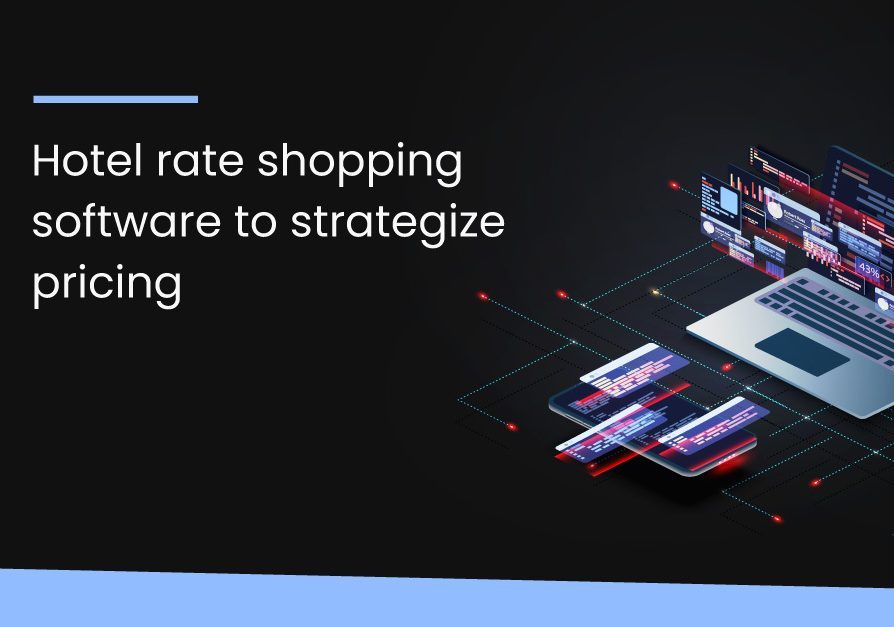
Hotel rate shopping software is a price analysis tool for hotels. It offers real-time rate intelligence and makes revenue management easy in a highly rate-sensitive hotel market. Here in this article, we’ll evaluate the role of hotel rate shopping tools in overall pricing strategy of hotels. Room rate is one of the key decision drivers in your business. It could simply be the reason why an individual chooses to go with you over your competition. Setting room rates is an intricate game; you need to gauge many variables and factor in market sentiment to come up with room prices. And to price room rates competitively, you need hotel rate shopping software. What is this tool? How does it function? And how it can help you strategize your hotel room prices better is what we are going to discuss in this post in greater detail. We will explore all the tool’s possibilities and the features you need to know before employing this tool in your business. So let us start with understanding the basics of this tool. What Is Hotel Rate Shopping Software? A Hotel Rate shopping tool does precisely what its name suggests. It helps you shop around for the rates of different hotels, including your competitors. It offers you insight into two critical variables of hotel room pricing – Rate Visualization and Rate Parity. Analysis of these two variables will form the foundation of your pricing strategy. Almost all rate shopping tools have filters that offer more micro details like a city-level view, area-level view, etc. Also, you can check your online ranking based on your current pricing structure. But what are Rate Visualization and Parity? Sound like jargon? Let’s break them down. a) Rate Visualization Hotel Rate Shopping Software will give historical rates and rate predictions of the hotels in your category, including your hotels. You can use the tool to visualize your rate for each room category for every day of the year and match those rates with your competition. The whole exercise put together is called “rate shopping.” b) Rate Parity The rates you see in the rate visualization module of a Hotel Rate Shopping software are crude, advertised rates. After checking out, an individual’s actual payment could vary hugely from the advertised rate. Therefore, making pricing decisions solely based on visualization will be premature. That’s why you need insights into Rate Parity. What’s Rate Parity? Rate parity is a cumulative comparison of room rates where every room component is compared with similar room components of other hotels. The breakdown of rate parity gives you a clear picture of what other hotels in your category are charging. With a hotel rate shopping tool, you can get comparable rate parity data of any hotel, inside or outside your competition. By now, you would be convinced that the rate shopping tools have value when it comes to knowing where your pricing stands compared to your competitors. But does it help in strategizing the long-term pricing of hotel rooms? The answer is a resounding yes. Next up, we are helping you explore use cases of hotel rate shopping tools that help you with a long-term pricing strategy. How to use Hotel Rate Shopping Software for Competitive Pricing? Devising a sustainable competitive pricing strategy using rate shopping tools is not a demanding task. All you need to do is use the data pulled by your rate shopper to your advantage. When you use a hotel rate shopper, you may uncover a lot of surprising data that you can use for your competitive edge. Here we are helping you by citing some possible use cases that can directly benefit you; if not, you can use them as a reference point to devise your own pricing strategy. a) Counter Pattern Once you employ the rate shopper tool, you will find most hotels have a pattern in their pricing. Many hotels will be using the BAR pricing module, which we won’t recommend if you are using a rate shopper tool. Cutting the chase, you will have to study and identify patterns in your competitors’ pricing, understand when they hike when they lower their prices and prepare a counter pattern of pricing that works for your advantage. b) SWOT Analysis Using rate shopper software for SWOT analysis of your existing pricing strategy can work wonders for you. You can start by comparing your online standings with your competitors. If you lack, you know what to do. If you don’t, market your standings and leverage them in pricing. Now you know the drill, you can explore many similar opportunities for better pricing and correction. c) Unearth the Unknown The odds are high that you don’t know where you outperform your competitors, as hotel room rates change like the values of stocks change in exchanges. We talked about patterns earlier. And here we take you to the point where you are breaking down rate parity and the numbers you unearthed through visualization. If you find you are outperforming your competitors in any category, you can use transparent pricing in that category, which is rare in the hotel industry. It will serve well both your marketing and sales objectives. Recommended: What is Loyalty SaaS Solution | Know different Vendors in the Travel Market There are no two thoughts about the insights hotel rate shopping software provides through rate visualization and parity modules. It helps you maneuver your day-to-day pricing. Also, as we mentioned, hotel rate shopper tools can be monumental in strategizing a long-term pricing strategy for your hotel. You can use the cases we mentioned as reference points and take the lead.
What is hotel upsell software? And how to choose one?
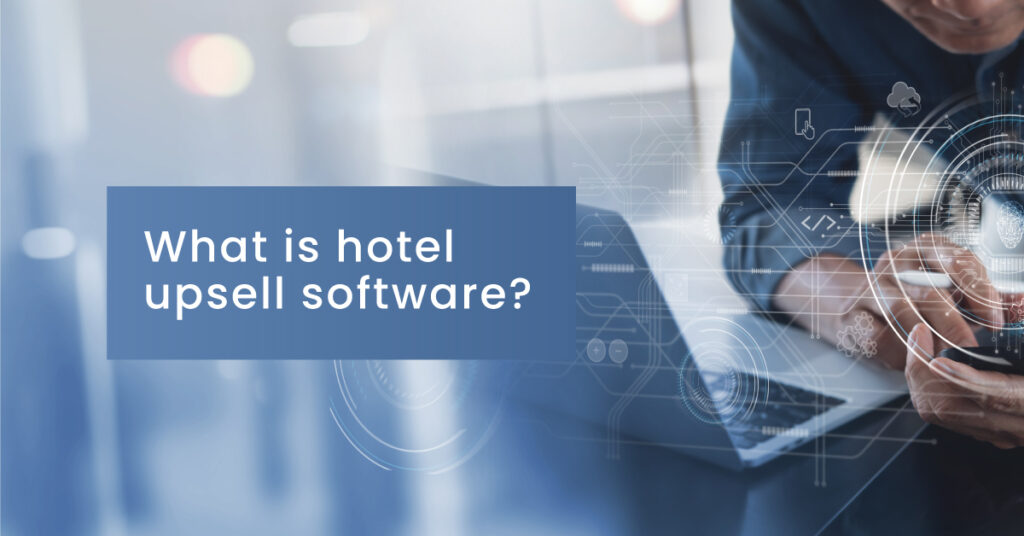
Hotel upselling software allows you to automate your upselling of hotel products & services using various communication channels and integrations. This article will explore how this tool works, factors to consider before choosing one, and some top solutions you must consider. Regardless of the hotel property type you handle; you need strategies and techniques to maximize your revenues from your existing customers; upselling is one of those crucial techniques that help you achieve this goal without affecting the customer experience. So, what’s upselling? It’s basically a method of convincing already interested customers to buy additional products and services at added cost. In the hotel industry, there are many ways and opportunities to do upselling. For example, you can offer customers a room upgrade before they check-in, or if you offer packages, you can upsell them by providing other amenities not included in the package. However, finding these opportunities and executing hotel upselling is a demanding task. That’s when the need for automating hotel upselling tasks presents itself, and hotel upselling software does it for you. What does a hotel upselling software do? As mentioned previously, the primary role of hotel upselling software is to automate upselling of hotel products and services. Having said that, how does this software achieve this automation, and how effective is it? Let’s try to answer it. The tools use different communication channels to reach guests with highly customized targeted offerings at various points of their journey. Many of these tools integrate post-stay guest communication with major travel review platforms like Trip Advisor, which becomes a reference point for other customers. Every user engaging with these reviews is a potential customer; the tools identify these individuals and groups and send upsell offers once they make a booking. The process eliminates the need for manual “upsell communication” from front desks. By now, you would be convinced about the utility of hotel upsell software. Yet an obvious thought that might strike your mind, which is, “are all hotel upselling tools good?” Not actually. Like all software solutions, there are good and bad hotel upsell tools. So how do you choose one? Next up, we are helping you with that by listing five critical components of the hotel upselling tool. Factors to consider for hotel upselling software The needs and requirements of different hospitality businesses vary. There is no one size fits all kinds of solution. Here we outline the essential features of hotel upselling software that will help you choose the right solution for your business. Availability of multiple communication channels Your upselling tool must offer you multiple guest communication channels that you can leverage to contact guests at various touch points of their journey. The software should at least offer communication capability with emails, chatbots, text messages, and live chats. Personalization suite Personalization rests at the core of any hotel upselling software. It should have provisions for dynamic room upgrade pricing, offer customization, and offer personalization. Automation capability Throughout this article, we have put thrusts on automation. Your hotel upselling tool must be able to automatically send offer emails, texts, and communication regarding offer redemptions and confirmations. Exclusion module Segmentation of interested and non-interested guests is crucial. Your hotel upselling software must have a module to perform this segmentation. And offer an exclusion module where you can list all the non-interested guests. Multidevice useability Your guest can use any device to book or modify their stay. And you never know the device they would use during their stay. Therefore, your hotel upselling tool should offer usability with all gadgets, laptops, smartphones, and tablets. 3 Prominent solutions to consider To choose a vendor for your hospitality business, you will have to factor in many variables like the size of your enterprise, the category of customers you deal with, etc. So, without delving into those variables or promoting any specific tool, we list the prominent vendors that fare well on the factors we mentioned above. EasyWay Easyway digitally tracks end-to-end customer journeys and pushes personalized upselling offers through popular messaging apps like WhatsApp, WeChat, iMessage, and other similar applications. Revinate Revinate’s USP is to offer hyper-personalized hotel products and services to targeted guests. The tool banks on establishing a deeper connection with the guest through its data-driven solutions to upsell hotel packages and room upgrades. Oaky Oaky is a commission-free hotel upselling engine that helps you easily automate upselling functions. It is one of those rare hotel upselling tools that gives guests absolute control over the deals they are getting from the hospitality businesses. The guests also get the flexibility to accept part offers. Recommended: What is loyalty SAAS solution Upselling is an excellent method to drive organic incremental revenues to any hospitality business. You offer additional value in exchange for an added cost, and there’s nothing unfair in this practice. Whereas upselling hotel products and services manually can trigger unpleasant customer experiences because you don’t have solid data to back your advances, and you don’t know if the guests are interested. Therefore, you need these hotel upselling tools that not only automate your hotel upselling processes but also ensure the function does not invite any bad customer experience. You can use the information in this article to select the right fit hotel upselling tool for your hospitality business.
Hotel property management system: Key features to look for and benefits
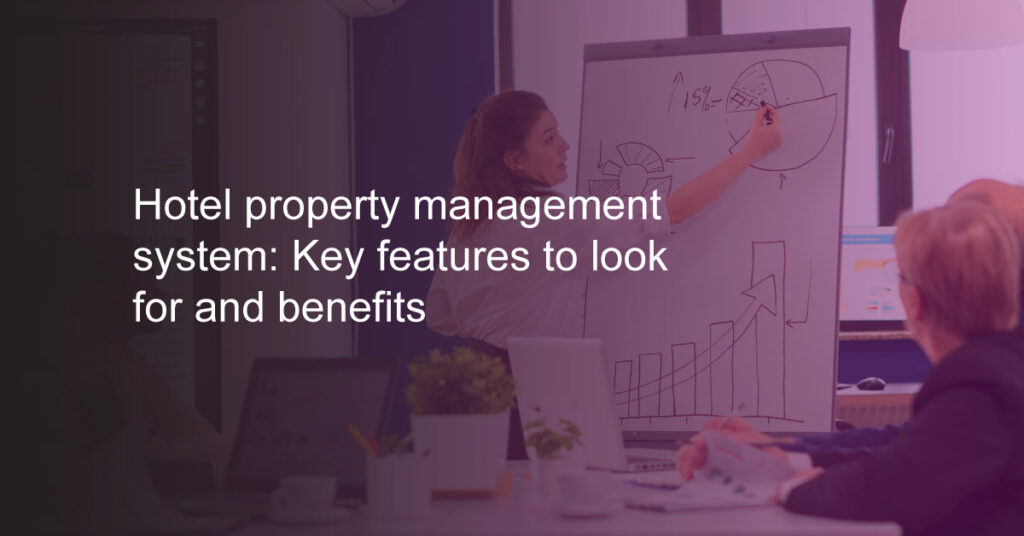
Running a hotel business involves many complexities. And as a hotelier, you are always on your toes due to the dynamic nature of the market. The market forces always keep pushing you. So, to remain competitive in the market, you must keep optimizing your processes, including your daily operations. A property management system lets you do that effectively by managing on-property engagements. Here, in this article, we will analyze the crucial features you should look for in a PMS and the benefits from its integration. Key features to look for in Property Management Systems The latest hotel property management systems are cloud-based and have multiple working environments and modules. However, certain features are central to hotel PMSs, and all modern property management systems should have them. We picked those essential features that should mandatorily make the cut in your PMS; the explanations of the same follows: #1 Front-desk operation module with booking integration The front desk operation module must integrate with the website booking engine and all the other third-party distribution channels. And there should be a user dashboard view that displays all the upcoming bookings, the current room availability status, and a tracking system for check-in and check-out. Also, the module should support payment processing and provide instant receipts to guests on their smartphones for their in-hotel expenses. It makes the check-out and the allocation of newly available rooms faster. #2 Distribution Management The distribution management feature in your PMS must integrate all your distribution channels – your hotel website, the mobile application you use for booking, the bookings that you receive from different online travel agencies and the channel managers. Also, the tool should directly connect to your central reservation system and provide you with a single dashboard, from where you can easily control your inventory and distribute it across channels. #3 Internal Operations Management The internal operations management functionality should offer you room status, cleaning alerts, and updates on the housekeeping staff. And the tasks assigned to the housekeeping staff should automatically be displayed on the front office system. So, the front office manager can keep a tab on the status of each room and prepare a maintenance schedule accordingly. #4 Revenue Management The revenue management module should have a clear interface that tracks, manages, and analyzes all your payments in real-time. And it must be able to accept and validate online payments. In case there’s a non-payment it should be able to manage the outstanding payment record. The list of features that we explained above is not exhaustive, beyond these, there will be a lot of common features. You can call the features we highlighted above “the bare minimum”. But you must make sure they are there in your property management system. Top benefits of employing a Property Management Systems So far in this article we have looked at the features so that you can develop an understanding of what you can expect from a property management system. Now we look at the larger picture – the eventual benefits of employing a PMS. #1 Smooth Check in/Check out Modern cloud based PMSs come with mobile integration. You get access to real-time guest check-in updates, and your front office can prepare in advance and facilitate fast and easy check-in. And with mobile-enabled guest service, the front office admin can keep tabs on when the guests are about to check out, furnish bills in advance, and facilitate smooth checkout. #2 Housekeeping efficiency The mobile-enabled guest services also increase the efficiency of your housekeeping staff. Your housekeeping gets real-time updates when the guests check out. They can quickly move to clean the room and make it ready for upcoming guests without any manual communication. #3 Back-office integrations The property management system allows you to integrate your core back-office systems. You can integrate your operation and finance processes and then manage accounts payable, receivable, industry and infrastructure applications through one view. #4 Access to enriched guest data The hotel property management also enables you to build centralized and secure guest data and improve the quality of your guest profiles. With inbuilt reports and analytics tools, you can understand the buying patterns of your past customers. And prepare more precisely targeted packages for potential visitors. #5 Revenue by selling the fitting room at the right The AI-powered revenue Management modules help you deeply analyze internal data and market dynamics from both the demand and supply side, which means you can optimize your rates to sell the right set of rooms to the right set of guests at the right time. And eventually realize increased revenues and profits. Recommended: Six leading in-room hotel technology trends in 2023 Conclusion! As we stated earlier, hospitality is a competitive market. And to be in the game. And keep competing with the best, you have to continuously get better at handling the booking cycle. It starts with an online search and booking process, peaks with on-property interaction between your staff and guests, and In-room experiences – that is your best opportunity to make it count. And then concludes with post-stay feedback. The property management software sits at the center of the booking cycle and gives you an opportunity to increase the efficiency of all on property functions of your hospitality business.
What is a travel metasearch engine, and how can travel brands benefit from it?
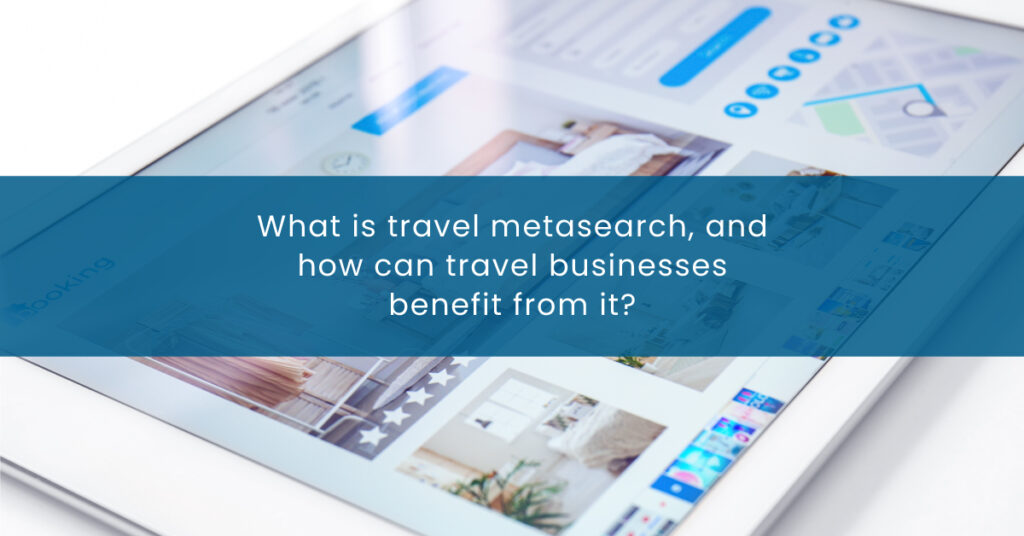
Travel brands are always on the hunt for new ways to attract travelers and direct bookings. They use display ads, search engine ads, native videos, and social media to drive engagement. An ideal marketing strategy would be to use a good mix of all these marketing channels. However, in today’s travel marketing scene, travel metasearch is emerging as a big platform to market. Metasearch advertising generated an economic value worth 6 billion USD in the last decade. As many as 60% of independent hoteliers consider metasearch the most effective marketing channel. Here in this article, we dissect travel metasearch for you, what it is, how your brand can benefit from it, and conclude by listing major engines. What is a travel metasearch engine? For travelers, metasearch is a platform where they can get an aggregated list of available rooms and their respective rates, saving them the trouble of visiting every travel website individually and checking for rates. Travel businesses see metasearch as a platform to market their brands and bring direct or sales-qualified leads to their website. Therefore, it also works as an acquisition channel. But please note metasearch is not a booking engine. It is a platform that pulls room rate and availability data from multiple sources on the internet. The bidding metasearch engine works on conventional CPC (Cost per click). You or your marketing representative will bid for your brand, and every redirection to your website will have a cost similar to how Google AdWords works. How travel brands can benefit from metasearch engines Metasearch can help travel brands in many ways. The brand can lift the conversion numbers without doing anything disruptive. Triptease report says “If your metasearch rates are accurate, your conversion rates can increase up to 300%”. It was about the ultimate outcome, but how do you activate it? As someone who’s just starting to use metasearch, what’s the ideal strategy to go ahead with? We are breaking it down for you in a three-tier approach, which will help you effectively get started with travel metasearch. Set the goals of the campaign Implementation of metasearch certainly boosts direct booking numbers, yet to make it a success, you have to set realistic expectations and plan your future budgets accordingly. For instance, if you are 10% direct booking, with metasearch, you can aim around 13-14%, take 5-7x return on ad spend for metasearch. Then, start the campaign. Once your campaign matures, you will have a clearer picture of how to adjust the budget. Maintain rate parity Travel metasearch engines optimize the rate to the user’s location and currency. Therefore, the odds of rate differentiation go higher, and if you are not keeping rate parity, you are giving your competition free winning edges. That’s why you must maintain rate parity across your distribution channels. Place rates strategically Placements of rates can have significant impacts on conversion. Only the advertisement competitive rates on metasearch will not be enough. When potential travelers land on your page, you must ensure that the first rate they see matches your advertised rate. The pricing technique is also famous with the name BAR (Best available rate) – always show BAR first. What are major travel metasearch engines, and who owns them? If we talk in terms of crude numbers, there are five major metasearch engines, Google Hotel ads planner, Tripadvisor, Skyscanner, kayak, and Trivago. Let’s look at them objectively one at a time. Google Hotels Google Hotels is arguably the market leader. The metasearch engine leverages google maps and Gmail to offer personalized recommendations to travelers. Google Hotels delivers travelers price tracking and deals directly to their inboxes. TripAdvisor TripAdvisor is also a well-known travel metasearch engine. You should have your TripAdvisor account up and running as soon as your hotel starts accepting bookings. The existence of your hotel brand on Tripadvisor gives you wider reach and acceptability. TripAdvisor Metasearch offers travelers direct booking and allows comparison shopping. Skyscanner Skyscanner is both a metasearch engine and travel agency. The booking tool is quite popular among gen-Z and millennials. Skyscanner offers its users’ destination research and booking travel products like flights, hotels, and cabs. Kayak Kayak is also both an online travel agency (OTA) and a metasearch engine. Kayak is a part Booking.com group, the group wholly owns the platform. Therefore, it’s not easy for other hotels to get ad placement on this metasearch engine. Though, hotels can get into partnerships with airlines and place packaged offerings on Kayak to derive the most value out of the metasearch engine. Trivago Trivago is a proper metasearch engine that fetches room rates and availability from different booking sites and shows it in one place. It has a revenue model like Google Hotels, booking sites have to pay a fee every time a potential customer clicks on a specific offering. Recommended: What Is Hotel Upsell Software? And How To Choose One? Ownership of metasearch engines matters a lot. Apart from Google Hotel and Tripadvisor the other three engines, Skyscanner, Trivago, and Kayak, are retailer-owned, so they send the major share of direct traffic to their own website. At the same time, media-owned travel meta-search engines are democratic and run transparent bidding systems. Metasearch is a powerful medium to get quality direct traffic to your travel website. Ideally, go with media owned metasearch engine and use the implementation strategy we mentioned earlier in this article. You will be all set to benefit from travel metasearch engines.
40+ Different Hotel Content Attributes That Users Check Before Booking a Hotel
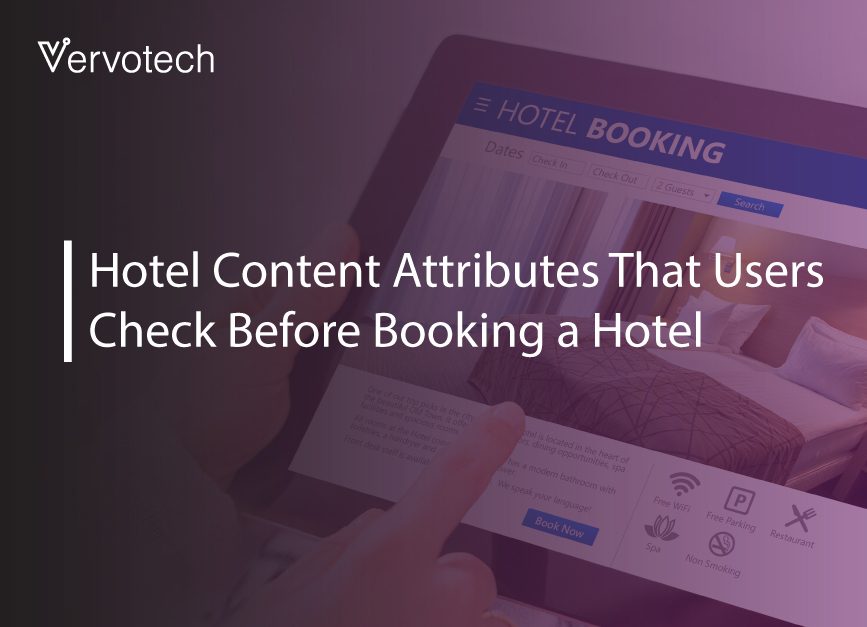
At a time when the majority of hotels are booked online, consumers try to find answers to their questions – what’s the pet policy, if smoking allowed or not, what are the pool hours, is there an in house restaurant – the information is nothing but hotel content and it should be accessible in minimal time because it takes only milliseconds for a user to switch to another website. While losing customers to competition because of operational inefficiency is something that you’d never want as an online travel business. Then, how to solve this conundrum? Can widening the set of attributes you display on your website solve this? Let’s find out! When the range of questions coming from consumers is widening, the set of answers you provide on your website should also widen. Although it’s understandable that data coming from multiple distribution channels is too cluttered to be displayed on websites. And keeping the hotel content data up to date all the time is another big challenge. To solve all the issues mentioned above on one platform, you need a dedicated master tool. A tool that maps the maximum number of attributes, so you can answer maximum customer queries upfront. There are Hotel Curated Content tools in the market that map up to 40+ attributes, allowing travel businesses to create sustainable travel businesses. These tools mostly run on AI/ML algorithms and keep your hotel content up-to-date with minimal human intervention. This empowers you to tell your best story to your potential customers. Now, let’s have a deeper look at how these 40+ hotel content attributes take form once mapped by a hotel curated content tool: Hotel Name: Online travel businesses work with multiple suppliers, and too often they end up mixing the hotel names, which creeps doubt into customer’s mind, and results in canceled or missed bookings. Top mapping tools use AI/ML algorithms to find out the correct name of the hotel and help you list accurate hotel names on your website. Property Type: Giving the consumer clarity about Hotel property types, such as – Motel, Resort, Villa, etc. attracts more customers, because when customers come online to book a hotel, they already have a property type in mind, if they don’t get the matching property or not enough clarity about the property type, they are likely to leave your hotel listing. Images: When it comes to hotel booking, images are key decision drivers. Hotel Curated Content tools provide image content through its network of exclusive hotel media content providers to make your hotel content completely ready for listing. Star Rating: With more customers going online, putting across their opinions on their travel experiences, star rating becomes very critical to establish the legitimacy and the quality of a property. Products like Hotel Curated Content map star ratings and provide strong social proof to properties. Email: To facilitate a smooth post-booking experience a Property’s email address is a very crucial denominator. There are scenarios when a user wants to connect directly to the hotel with their special requests, email addresses come very handy in those situations. Curated Content Tools accurately extract email addresses of properties from your suppliers’ data and add them to your hotel content. Geocodes: At a time when everyone owning a smartphone has access to GPS technology, not providing accurate geocodes can be very counterproductive for any travel business. Curated Content Tools add accurate geocodes to your hotel content by leveraging highly efficient AI/ML algorithms. Address Line1: Usually property addresses have two lines, to avoid any missing important address data, the hotel content mapping tools capture the full address in its natural form and list the first line of address in Line 1. Address Line2: Detailed location information of a property comes in Line 2 of the address. Country Code: HMC Tools map Country Codes provided by the International Organization for Standardization to avoid mix and match of country names in the content. Supplier Name: When you take services of multiple suppliers, you must know the name of the supplier providing that hotel. Supplier Hotel Id: You get access to a consolidated list of property IDs provided to you by your suppliers. Recommended: Hotel Data Duplication: How To Solve The Growing Challenge For Hospitality Industry City Name: Name of the city where the property is located. State Name: Name of the state where the property is located. State Code: Code of the state where the property is located. Zip Code: Zip Code of the area where the property is located. Country Name: Name of the country where the property is located. Latitudes and Longitudes: Latitude and Longitude of the property to get precise direction and location of the property. Phones: Property’s phone numbers. Fax: Property’s fax number. Website: Property’s official website address. As Hotel Content plays a very crucial role in the booking process, with a quality Hotel Curated Content tool, you can easily list all the aforementioned attributes properly on your travel website. And put your travel business in a position that allows you to present your best story to your potential customers, and also take your conversion numbers up north. Vervotech is a leading Hotel Mapping and Room Mapping API that leverages the power of AI and ML to quickly and accurately identify each property listing through the verification of multiple parameters. With One of the industry’s best coverage of 98% and an accuracy of 99.999%, Vervotech is quickly becoming the mapping software of choice for all leading global companies operating in the travel and hospitality industry. To learn more about Vervotech and the ways it can enhance your business in the long run contact us: sales@vervotech.com
Four smart ways to build a solid hotel positioning strategy
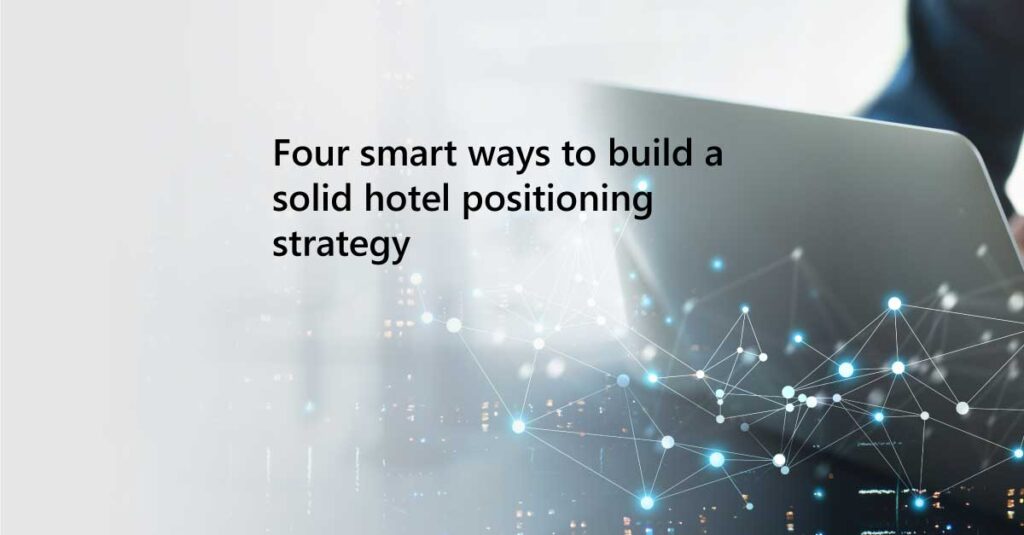
When traditional hoteliers would think of branding, they would get a unique logo and put it almost everywhere, from adverts, to the front desk and the uniforms of their staff. Boom! They would believe they did an excellent job branding their hotel brand. They probably did because only a handful of players had the wherewithal to do branding. However, now digital has democratized access to advertisement channels. Not only your core competitors but a player who just entered the market can challenge you and eat a fair amount of your business. So, how do you stand out in a crowded market? For that, you must position yourself uniquely. Once you figure out your positioning, all critical functions of your business, like Marketing and Sales, will be able to leverage that to sell your hotel brand effectively from a better vantage point. Hotel positioning is creating a unique, differentiated image or identity for a hotel in the minds of consumers to make the hotel stand out from its competitors. Hotel brands typically achieve it through marketing, branding, and developing unique amenities and services. For example, a luxury hotel might focus on its elegant decor, fine dining options, and high-end spa services to attract wealthy, discerning travelers. On the other hand, a budget hotel might focus on its convenient location, affordable prices, and basic amenities to appeal to cost-conscious travelers. Another example of hotel positioning could be a hotel that positions itself as a family-friendly destination, offering kid-friendly amenities and activities, such as a pool, a game room, and a playground. This type of hotel might target families with young children as its primary customer base. The goal of hotel positioning is to create a clear and compelling image of the hotel in the minds of consumers. And to differentiate the hotel from its competitors in a way that resonates with its target audience. There are many ways you can achieve it. Here we talk about four strategies that can stand out in today’s market and help you create a unique proposition for your hotel business. Turn the table When you find nothing on the table, turn the table. Yes, turning the table can establish yourself as a unique brand. How? By turning the table, we mean thinking unconventionally. When everyone is looking to introduce some breakthrough, you can focus on the ordinary and position it as a luxury. How will this work? Only some people want everything. And there are a lot of people who want basic things right. Find the essential things not many in the industry sell, but you do. Like there are many corporate travelers who already have had enough of luxury, all they want is an experience that is close to the comfort of home. Rather than selling them the luxury of hotels, sell them the comfort of home. Create blue ocean By creating a blue ocean, we mean creating a whole new category altogether. One step ahead from “turning the table.” The way OTTs brought live sport on the internet. Once you can redefine a category, you redefine a market and the competition. You will have the first-mover advantage, and everyone else will play a catch-up game. Couple-friendly hotel was a blue ocean someone, pet friendly for others. You can create a category, something like “toddler-friendly” hotels, and be a leader in that market. Get one past one To do a lot better, you don’t necessarily need to do a lot. When we say, “get one past one,” we mean thinking about the number one in your industry and finding out what’s that one thing you can do better than them. Find that UNIQUE spot of differentiation, and market it. Or maybe copy it as well. Nothing’s wrong in love and business. Be anti-establishment Today if you glance over social media, you will find everyone is anti-something. It’s true for your industry as well. That means people are telling you to be what some of the best players in your class are not. Gather that data about the established players in your industry and find the category that allows you to be the best “anti-establishment.” Here, you have your differentiation. Be a hero in your class by not doing what heroes do. You can do this by active social listening, observing the adverts and messaging of bigger brands, and finding the areas that travelers detest. Once you find that sweet spot, tailor a perfect anti-establishment messaging, which will help you garner the support of those individuals who don’t like the identity of certain brands, and there is a high chance they will switch to you. Recommended: Six Leading In-Room Hotel Technology Trends In 2023 By following these four smart strategies, you can build a unique and compelling hotel positioning strategy. Remember, the goal is to differentiate yourself from the competition in a way that resonates with your target audience. With the right positioning, your hotel business can stand out from the crowd and attract more customers. Vervotech is a leading Hotel Mapping and Room Mapping API that leverages the power of AI and ML to quickly and accurately identify each property listing through the verification of multiple parameters. With One of the industry’s best coverage of 98% and an accuracy of 99.999%, Vervotech is quickly becoming the mapping software of choice for all leading global companies operating in the travel and hospitality industry. To learn more about Vervotech and the ways it can enhance your business in the long run contact us: sales@vervotech.com


